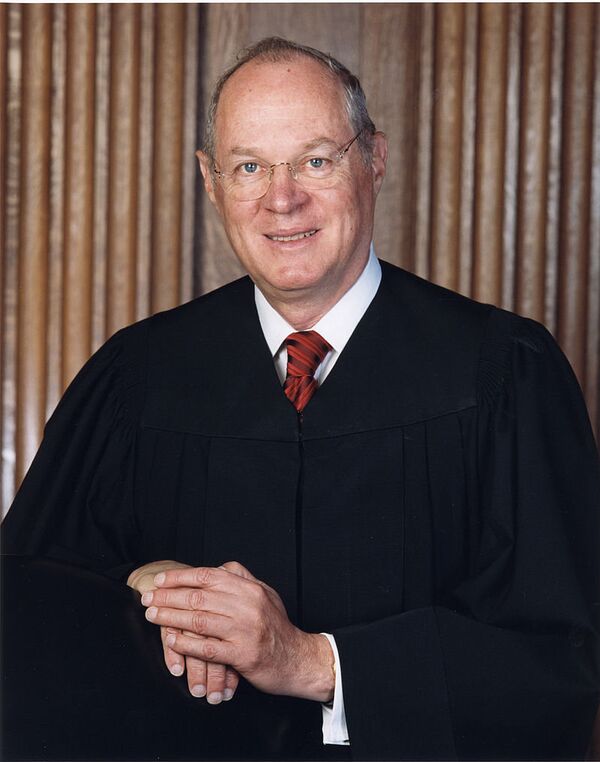It was announced on Wednesday, June 27, that Kennedy, 81, will retire from the Supreme Court of the United States, sometimes referred to as SCOTUS, on July 31.
Kennedy — who was nominated by President Ronald Reagan back in 1987 — took a liberal stance on gay rights, banning capital punishment for the youngest criminals, and limits states' ability to enforce harsh immigration laws, but he also voted to gut the historic Voting Rights Act and wrote the majority opinion in Citizens United v FEC, which enabled corporations and unions to spend an unlimited amount of money on elections.
It will now be up to President Trump to decide whether to try and nominate a replacement before the mid-term elections in November or wait until afterwards, when the complexion of Congress could have changed.
Under the US constitution those nominated to the Supreme Court by the President have to be confirmed by Congress and since 1990 the grilling has become more and more heated.
“There should be no consideration of a Supreme Court nominee until the American people have a chance to weigh in. McConnell set that standard in 2016 when he denied Judge Garland a hearing for nearly a year, and the Senate should follow the McConnell Standard." pic.twitter.com/8NkfmAXtpH
— Seth MacFarlane (@SethMacFarlane) 28 June 2018
David H. Souter
In the late 1980s and early 1990s several Supreme Court judges retired, leaving President Reagan and his successor George H Bush with the choice of who to pick.
One of Reagan's conservative picks, Robert Bork, was rejected by a Democrat-dominated Congress in 1987 so Bush picked the low-profile and relatively uncontroversial Souter in 1990.

He was seen as a "stealth justice" who had a minimal record of controversial rulings but the National Organization for Women suspected he was anti-abortion and protested at his confirmation hearings.
But Souter was chosen after 20 hours of confirmation hearings.
Clarence Thomas
If Souter's confirmation hearings were a "storm in a teacup" then Clarence Thomas's in 1991 were a full-blown hurricane.
Although he was only the second African-American to be nominated to the Supreme Court, Thomas had a record of conservative rulings and was already due a hard time from the Democrats.
But the trouble really began two days before the Senate hearing when allegations of sexual harassment and misconduct by Anita Hill, an attorney and former underling of Thomas, were leaked.
Thomas was confirmed by a 52-48 vote in October 1991, the narrowest margin for approval in more than a century. Now 70, he remains a US Supreme Court justice.
Ruth Bader Ginsburg
By 1993 the Democrats controlled both Congress and the White House.
So when President Bill Clinton nominated Ruth Bader Ginsburg, a liberal who was pro-choice, she was a shoo-in.
But her confirmation hearings still took 20 hours as Republicans tried to catch her out but she was voted in by 96 votes to three.
Ginsburg is the first Supreme Court justice to officiate at a same sex wedding, in 2013.
John G. Roberts
After Stephen G Breyer's selection as an Associate Justice in 1994 there was an 11-year gap before another vacancy arose on the Supreme Court.
In July 2005 President George W Bush nominated a conservative, John G. Roberts, who had been a legal adviser to his brother Jeb, for the vacancy created by the pending retirement of Sandra Day O'Connor.
So the UK supreme Court is moving from 16.6% to 25% female, so just 25% more to go before equality has been achieved. #UKSupremeCourt meanwhile in the US, we can expect #SupremeCourt nominee to think Clarence Thomas was liberal.
— Siobhan Lydon (@SiobhanLydon) 28 June 2018
But when the Chief Justice of the Supreme Court, William Rehnquist, died suddenly in September 2005 Bush reconsidered and nominated Roberts for the top job.
Despite the best efforts of Democrat senators Ted Kennedy, Joe Biden and Dianne Feinstein,Roberts was approved by the Republican-dominated Senate by 79 votes to 22.
My statement on the retirement of Justice Kennedy.
— Ted Lieu (@tedlieu) 27 June 2018
“The American people should have a voice in the selection of their next Supreme Court Justice. Therefore, this vacancy should not be filled until we have a new Congress.”
Merrick Garland
Bush's next nomination, Samuel Alito, was approved in 2006 and three years later Barack Obama's first nominee, Sonia Sotomayor sailed through 68-31, followed in 2010 by Elena Kagan.
But when 79-year-old Antonin Scalia died in February 2016 it left a vacancy on the Supreme Court which was difficult to fill considering it was an election year.
Obama, the lame-duck president, nominated Merrick Garland, the Chief United States Circuit Judge for the US Court of Appeals for the District of Columbia in Washington.
Garland was eminently qualified for the job but his liberal credentials — he had been promoted by Bill Clinton and had been on an appeal court panel which overturned the Combatant Status Review Tribunal's that a captured Uighur detained at Guantanamo was an "enemy combatant" — turned off Republicans.
But most of all they hoped a Republican President would be in the White House by November and in an unprecedented move they refused to hold confirmation hearings at all and 293 days later Garland's nomination expired.

Neil Gorsuch
The Republicans having succeeded in blocking the nomination of Garland, they then waited for the new President, Donald Trump, to nominate a conservative to fill the vacancy.
He picked Neil Gorsuch, a 49-year-old Denver-born former appeal court judge who was at the time teaching at the University of Colorado Law School.
Despite attempts by Democrats to question his qualification for the job, he was approved by 54 votes to 45 and became an Associate Justice of the Supreme Court, on April 10, 2017.


